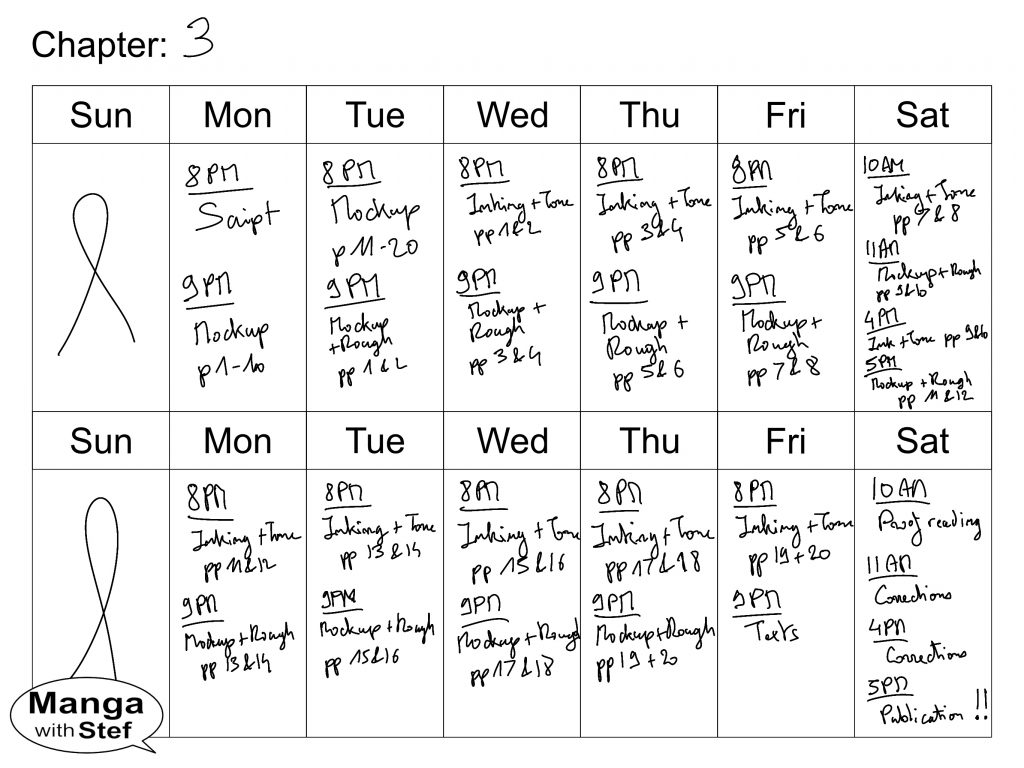Manage Your Manga Realization Planning

Manage Your Manga Realization Planning
Publishing a series, be it for a manga, a web comic…, generally comes with deadlines. When you are new to it, it can quickly become a huge source of stress which could lead you to even dislike making manga. This is why having a realization planning for your manga can be important. It will ensure that making your series goes as smoothly as possible, and help you taking advised decisions.
What is a planning and why you need it
A planning is the set of activities needed to realize a project, a manga chapter in our case, positioned logically on a timeline. Each activity has a start date and time, and a duration. This gives you a clear indication of when the activity is expected to be performed, and what effort it is expected to require.
The planning is defined before the activity starts, and the progress of each activity is tracked during the realization of the project. The objective is for you to get a clear view of your progress, and on what remains to do. This will also allow you to know if you are on time or late, and to take appropriate decisions.
By monitoring your activities over the realization of a few chapters, you will be able to set a manageable work rhythm.
This will ensure you properly manage the stress that goes with any project delivery, and therefore keep enjoying publishing your series.
Building your planning
The first step in making a planning is to have a clear idea of the tasks that you need to perform. I give below what I think is the nominal set of activities required for the realization of a manga chapter. And this both in the case of a serial (the plot spans over many chapters) or episodic (there is a new plot for every chapter or so) manga series.
Next, you must also have an idea of the number of pages you want to produce for each chapter. For reference, a standard manga chapter is 18 to 20 pages long. This is around 72 to 80 panels with an average of 4 panels per page. For a web comic, you have more freedom in the length of an episode. But keep in mind you need to provide minimal content if you want readers to keep reading your story. You can use the number of panels of a standard manga chapter as a baseline here also.
Identifying the activities for a serial manga series
If you are working on a serial manga series, I assume that you already have prepared your story. I mean by that that you have the outline of your story, your character design and your character arcs. The outline lists the different steps that your story will take, from the start to the finish. If you don’t have it, read my article on how to build a manga story outline. The character design sets the background and visuals of your story. Learn how to create your character background and visual if you don’t have them yet. And finally your character arcs indicate how your characters will evolve along your story. Discover how to build a character arc if you don’t have any. These are important to make sure your story will remain coherent.
As a start, the first activities will consist in defining and detailing the exact content of your chapter:
The objective of this first part is, based on your story outline, to detail the content of your chapter, and to ensure this fits in the identified number of pages.
Then, for each page (including title pages):
- Do the page’s mockup
- Do the rough sketch the page
- Ink the page
- Tone the page
- Add the text
- Review the page
Finally, once all pages are finished:
- Proof read your chapter
- Revise your chapter
And finally, once everything is ready, don’t forget you need some time to:
- Publish your chapter
Identifying the activities for an episodic manga series
In the case you are realizing an episodic manga series, you might have some extra steps:
- Find an idea for your chapter
- Design the characters specific to the chapter
Once the idea for the episode is found, and the new characters are designed if any, then you can follow the same steps 1 to 10 as for a serial manga series.
Planning activities
Now that your tasks are identified, the next step is to plan them.
Identifying time available
What you need first is to know the duration you have available to produce a chapter. If you are working for an editor, you might have deadlines every week, two weeks, every month…
If you are self-paced, you have to set a manageable delivery schedule. It is important if you want to keep your audience satisfied. Publishing every now and then might work, but you might lose the interest of many of your first readers along the way.
Then, after the deadline, you must also identify how much time you have available to perform the activities. It might be 8 hours per day, from Monday to Saturday. Or 2 hours per day from Monday to Friday. …
Planning the activities is then simply identifying when a task will be performed, and how much time you expect to spend on it.
Grouping or not grouping activities?
Even though I listed 10 activities for the realization of a manga chapter, you can group some of these activities under a single activity. For instance can regroup “page mockup + rough sketch” in a single activity. By default there is no problem with that. But if you have quite some systematic delay on that group activity, you might have to separate them later on. This will allow you to track more specifically if you have under-estimated the time required to do the page mockup or the rough sketch. Then, you can either give more time for the incriminated activity, or try to improve your technique on that aspect.
Page per page or batching
A last element that is to be considered is the manner you want to proceed for your pages. There are basically two approaches:
- The page by page approach, where you will perform activities 3 to 8 page by page
- The batch approach, where you will perform activity 3 for a bunch of pages, then activity 4…
I guess you have to test both approaches to see which you like the best. The main difference between the two is that you will be switching tools less frequently with the batch approach. But you might also be inking for hours… With the page by page approach you will be shifting activities more frequently, which might therefore make activities seem shorter and break the routine or stress.
Example

Let’s take an example. Let’s say for instance I’m publishing a serial manga series and:
- I have 2 hours per day from Monday to Friday, and 4 hours on Saturdays.
- I plan on delivering a 20 pages chapter every two weeks.
- I will batch pages by 2
Here is what the planning could be looking like:
Tools and supplies
You don’t need anything fancy or costly to make your planning. For instance, you can use a simple sheet of paper (like the example above) that you pin on a wall, or you can also use a diary.
If you also have different options if want to follow up your manga realization on a computer. You can for instance use a calendar (like Google Calendar if you have a Gmail account) or a spreadsheet.
What is important is that you can keep it simple and easily accessible.
Follow-up your planning
Track task completion and delays
The follow-up of your manga realization planning has for primary objective for you to track the completion of your activities. It is always satisfactory to tick something as done to keep your motivation. And it is also important to know you are late in regard to your schedule.
Actual durations
The second step will be to track the time spent on each activity.
Here you either have to track the time at which you started an activity, and the time at which you completed it. The objective is to more finely be able to track the actual time spent on a task, or a set of tasks.
From that time tracking, you will be able to determine if you are:
- Ahead of time – 15 minutes or more ahead of schedule for a 1 hour activity
- On time – 15 minutes or less ahead or above schedule for a 1 hour activity
- Late – 15 minutes or more above schedule for a 1 hour activity
If you are ahead of time, that’s great! You can anticipate your next activities or you can get some spare time.
If you are late, you can extend your hours or prepare for some extra work the next day (have a look here to see how to address delays). This isn’t dramatic to be late for one activity. This becomes more a problem if you are systematically late, and this will require some corrections later on.
Activity complexity
As a third indicator, we will evaluate if we found the activity complex or not. Again we can use 3 levels:
- Low complexity – The task was easier than usual. For instance, the script was easier to write as the chapter focused mainly on fight scene.
- Standard complexity – The task complexity was nominal. That would be drawing panels with a few characters and some basic backgrounds.
- High complexity – The task complexity was high. For instance the drawings were complex with lots of details, like having a forest with many varieties of trees, flowers and animals to draw.
Stress level
And as a fourth and last indicator, I would also track the stress level at the end of the activity.
You can for instance use a 3 levels indicator:
- Low – Do you feel fresh and ready to do more right now?
- Moderate – Do you feel fine and ready to continue after a break?
- High – Or do you feel stressed and tired, and do you feel nervous for the next day?
Don’t confuse stress and mood, these are totally different things. The mood is an indication of your emotions. The stress level is an indication of your mental energy level. For instance you can feel happy after the completion of a task, and still be mentally exhausted.
Your mood can counterbalance a temporary low level of mental energy. But a continuously low level of mental energy will take its toll on your mood and health on the mid to long term. If you let stress takeover, this might impair your liking and engagement in the realization of your manga.
Note also that that stress can come from the manga realization itself, or from external factors.
Managing delays
You are late on your planning realization. The question is now to determine how you can recover?
Here are two possible options to quickly answer the problem:
- Work some extra time on the activity to complete it on the due date. Don’t forget to track the extra time spent and your mood.
- Simplify the end of your chapter. This is commonly found in some Japanese manga chapters who for many have strong deadline constraints. You can start by simplifying your backgrounds by using speed lines or screen tones. You can also remove some panels and add more text to compensate.
Whatever, take note of it on your planning.
Retrospective and correction of your manga realization planning
Objective of the retrospective
Alright, you finally delivered your manga chapter pages.
The last stage in the management of your manga realization planning is to do a retrospective. This part will be really important at the beginning of your series, where you might be calibrating things. But on the mid term this should become less needed as time passes.
The objective of this retrospective will be to review what went well and what didn’t. Then, if needed, you will try to correct these points for the next iteration of your planning.
When is it required? And when isn’t it?
Of course, if everything went well, if you don’t foresee any technical problem or feel stress for the realization of the next chapters, you might skip this planning revision step and re-use the same planning structure.
But if you faced multiple delays, if you felt over stressed at time or if you feel some stress when thinking to your next chapter, then this might be a really good idea.
Pieces of information needed
This is where the indicators we mentioned earlier come into the play:
- What was the time spent on an activity?
- What was the complexity of an activity?
- What was your stress level at the end of the activity?
Complexity and time spent have to be analyzed relatively, the one is useless without the other.
Basically if you had some more than usual complex part of the plot to write, this can explain some delays. Also easier than usual panels to draw might explain why you were ahead of time.
And again, stress is key to monitor to ensure long term satisfaction in making manga.
For activities that were repeating (like inking…), make an average of the different instances of the activity. For instance if over 10 instances you were twice “late”, and the remaining times “on time” or “ahead of time”, you can consider you were generally “on time”. But if you were 4 times “late” and the remaining times “on time”, you can consider you were generally “late” on that set of activities.
Revising your manga realization planning
The objective is to make the realization of your manga something that you enjoy. The objective will therefore be to ensure your stress level remains low or moderate.
Here are some guidelines to help you revise your manga realization planning:
- If your stress level was high after completing a low or standard complexity activity:
- First, you have to identify what was the cause of the stress. Was it the activity itself? The fact that you had some extra homework to do? Your kids to take care of? …
- Most of the time, giving you more time to do the activity should help reducing the stress. For instance, extend the duration by half of the initial duration (1 hour to 1.5 hours…). This will help decreasing the stress related to the expected deadline by giving more time to do the activity. This might also give room for some rest. or to absorb unexpected but recurring events. You will of course have the possibility to reduce the duration later on if you feel comfortable to do so.
- If you were late on a low or standard complexity activity:
- here also, try to identify the cause of the delays. Did you face difficulties drawing characters in certain positions? Did you struggle with finding ideas for your chapter in you gag manga? Did you struggle doing the panelling or drawing onomatopoeias?
- Here again, consider, as a start, extending the duration of the activity by half the duration of the delays you experienced.
- Then, give yourself some extra time to increase your skill on the aspect causing delays. Do some practice on drawing characters. Follow some courses on finding ideas…
- And finally, if you were ahead of time with low level of stress on some activities:
- you can consider reducing the duration of the activities. For instance reduce the duration by 10 or 15 minutes for each hour initially planned. Or you can keep duration as a buffer for some other activities or for some rest.
In the end, the objective is not to find the perfect durations to the minute. As indicated above, the objective is that you are “on time” for standard complexity activities the majority of the time, with low stress. And you will be ahead of time because something was easy. And also at times “late” and “stressed” because something was complex and required intense focus. Overall, the objective is that your willingness to make manga stays high.
What if it does no longer fit?
If you can no longer fit your planning in the intended timeframe following your planning revision, you have three options:
- Move your publication deadlines – For instance you can move on a 3 weeks schedule instead of two (given this deadline is not imposed to you). And don’t fear explaining the reason why you changed your publication schedule to your readers. They will understand and prefer less frequent updates to your manga losing quality or suddenly being stopped because you did a burn out.
- Simplify your pages – The objective is to draw what is essential to your story. Simplify what remains: remove unnecessary panels. Add text bubbles to write instead of drawing. Simplify backgrounds, use speed lines and simpler shadings…
- Get an assistant – If you can’t run away from your deadlines, and/or if you refuse to degrade the quality of your manga, then find someone that can support you in performing part of the activities. For instance you can get someone to do the backgrounds, secondary characters or the shadings. On your side you will focus on the story, rough sketches and main characters. This is a frequent setup for a manga studio.
Do not hesitate if you have comments, questions or suggestions!
Stef
